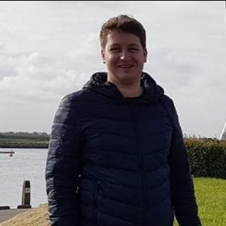Robert van de Velde joined ImPhys as MSc student
A passion for numbers and natural phenomena led him to the study of applied physics in Delft. He did his bachelor applied physics there as well. Besides his studies he spend a lot of time on software development for performing data processing, modelling and visualization.
His MEP project at Mars Lab will be about improving the homogeneity of the B1+ field for high-field MRI scanners using dielectric blocks with a high relative permittivity. At high magnetic field strengths, the Larmor frequency increases which implies that the required RF wavelengths become shorter and approach the size of the human body, and thus interference effects come into play. This can lead to an inhomogeneous RF exposure and thus cause signal drop-off in MR images. The displacement current in the dielectric blocks generates a secondary magnetic field that can locally modify the B1+ field. The blocks have switchable connections to allow for current flow between blocks so that additional dielectric configurations are enabled. The task is to design a device that automatically yields the most homogeneous B1+ field for as many cases as possible. This will be done using computer simulations and experiments on phantoms.
His supervisor is Sebastian Weingartner
